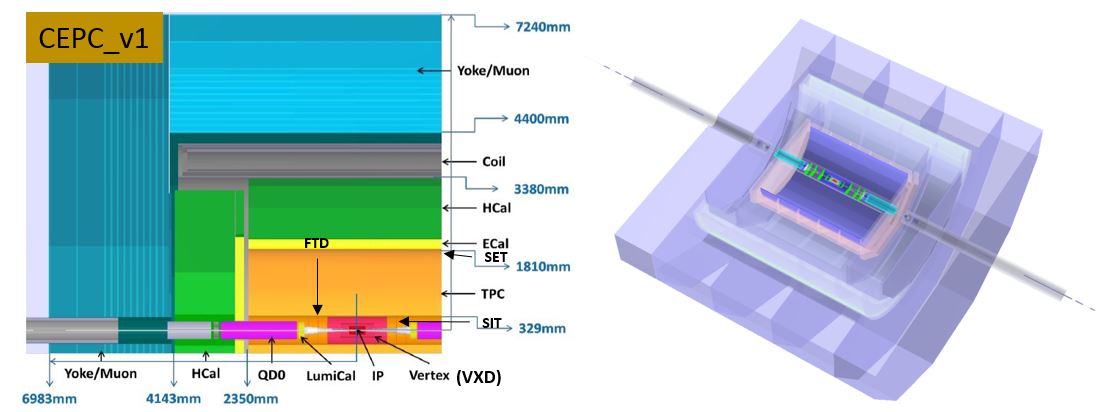Detectors
Estimated reading time: 3 minutesThe first CEPC detector for wide physical study is a ILD-like detector. In CEPC software, the CEPC detector model is often regarded as
the detector, and the versions of detector models are used to denote the different detectors. The first ILD-like detector is called
as CEPC_v1. The whole detector compose of the beam pipe, the mask, the vertex detector, the LumiCal,
the SIT, the TPC, the SET, the FTD, the Ecal, the Hcal, the Coil and the Yoke, as show in
Based on this ILD-like detector, more modified detector models are being considered and studied, such as using a full silicon tracker as tracking detector. Currently, we have released three versions of detector models (CEPC_v1, CEPC_v4 and CEPC_v5). The CEPC_v1 is based on a single beam pipe, but the CEPC_v4 and the CEPC_v5 are based on a doubly-crossing pipe whose crossing angle is 33 mrad. Other difference between them dominantly lies on the optimization of calorimeter.
| sub-detector | parameter | CEPC_v1 | CEPC_v4 | CEPC_v5 |
|---|---|---|---|---|
| MDI | single pipe | doubly pipe | doubly pipe | |
| Lcal | Radius | 60mm~172mm | 30mm~100mm | 30mm~100mm |
| VXD | Length/R | 62.5mm/16mm,125mm/37mm,125mm/58mm | ||
| SIT & SET | Radius | 153mm, 300mm, 1811mm | ||
| TPC | sensitive Radius | 384mm~1718mm | ||
| drift length | xxxmm | |||
| Ecal | layer number | 30 | 30 | 25 |
| cell size | 5mm | 10mm | 10mm | |
| silicon thickness | 0.5mm | 0.5mm | 1mm | |
| total tungsten thickness | 2.1mm20+4.2mm10 | 2.1mm20+4.2mm10 | 3.36mm*25 | |
| inner radius of endcap | 226.8mm | 245mm | 245mm | |
| radius | 1843mm~2028mm | |||
| z of endcap | 2450mm~2635mm | |||
| Hcal | layer number | 48 | 40 | 40 |
| Yoke | ||||
| Field | 3.5T | 3.0T | 3.0T |
MDI
While pre-CDR studying, the design of MDI based on single beam pipe was considered. But now, on the CDR stage, it is almost sure to use doubly-crossing beam pipe at the IP. Therefore, we can focus the detector model on the doubly-crossing beam pipe. For this MDI, the detail design is also being optimized. In order to distinguish them, we use the date of design to tag the version of MDI. Currently, there are two dominant version: 20170926 and 20171220.
Note that the simulated physical study only depend on the short beryllium pipe generally. Since the beryllium pipes are similar even same in different version, the physical study can ignore the difference of detail MDI design. But other study, such as radiation dose, should pay attention on them.
Tracker
The tracker system in the main CEPC detector includes the vertex detector (VXD), the SIT/SET, the TPC and the FTD. The TPC is the main tracker. Except TPC, the other sub-detectors are based on silicon technology. The VXD has three double-pixel layers. The SIT has two double-strip layers for inner position-enhance and the SET has one double-strip layer for outer. The FTD is the tracker at forward region, composing of two single-pixel layers and three double-strip layers.
Besides the TPC design, the other main trackers are also being considered. Till now, there are the following main tracker:
- TPC
- Full silicon tracker
- Wire chamber
Calorimeter
The calorimeter system includes the electronmagnetic calorimeter (Ecal) and the hadronic calorimeter (Hcal). The Ecal is silicon-tungsten sampling calorimeter. The Hcal is RPC-steel sampling calorimeter. Some optimizations have been done, which can be found at https://arxiv.org/abs/1712.09625.
Note that the CEPC software can also support scintillator as sensitive material or use other radiator material.
Yoke
Luminosity calorimeter
Magnetic field
We have two version of magnetic fields now. The nominal field values are 3.5 T and 3.0 T, respectively. And a reverse field is added onto the Yoke region.
Note that the field is uniform in current CDR study.
